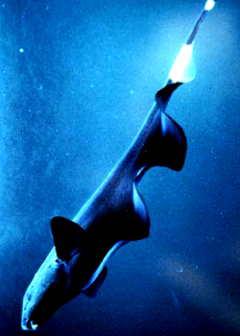Water moves improved by oceanic android
 Researchers are working on a highly-mobile new robot with some astounding aquatic abilities.
Researchers are working on a highly-mobile new robot with some astounding aquatic abilities.
In the Amazon basin there lives a creature called the black ghost knifefish, Apteronotus albifron, and aside from having one of the best names in the animal kingdom it is known for its electric charge and incredible agility.
Now, a team from the Northwestern University in the US is reverse engineering the black ghost knifefish to steal its secrets for the design of a new robot.
The interdisciplinary team of researchers hope to develop agile fish robots that could vastly improve the state of underwater vehicles. The swim-bot would be used to study fragile coral reefs, repair damaged deep-sea oil rigs or investigate sunken ships.
"Our technology for working in water is not very advanced," said Professor Malcolm MacIver, a robotics expert who has studied the black ghost knifefish for two decades.
“Current underwater vehicles are large and lack agility, which means that working close to living or manmade structures is nearly impossible. We've taken lessons learned from the knifefish about movement and non-visual sensing and developed new technologies that should improve underwater vehicles.”
The black ghost knifefish hunts in the murky rivers of the Amazon using fine sensing and movement systems. It has the unique ability to sense its surrounds with a self-generated weak electric field and to swim in multiple directions. It can move both forward and backward as well as vertically using a ribbon-like fin on the underside of its body.
MacIver and colleagues have developed more several prototypes based on the electric black ghost knifefish. A major motivation for using this fish in particular has been to generate a better understanding of how the nervous system combines the acquisition of information with movement.
Future integration of electrosense and ribbon fin technology into a swimming robot should result in a vehicle capable of navigating complex 3-D geometries in murky waters, tasks that are impossible with current underwater vehicles.
In the following video, ‘Ghostbot’, derived from the layout of the knifefish, demonstrates ‘nodal point control’ in which the robot’s position is controlled by a closed-loop positioning algorithm which shifts the point at which inward counter-propagating waves meet.
GhostBot: Counterpropagating Waves with Shifting Nodal Point from NxR Lab on Vimeo.








 Print
Print